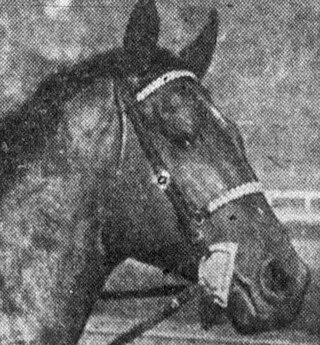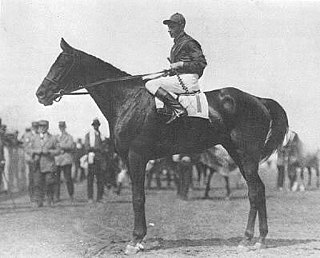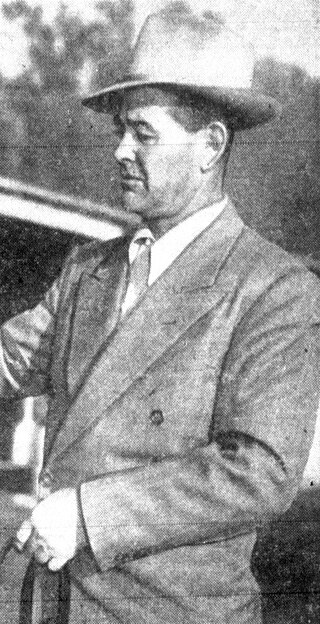Related Research Articles
Lucien Laurin was a French-Canadian jockey and Hall of Fame Thoroughbred horse trainer. He was best known for training Secretariat, who won the Triple Crown in 1973.
Greentree Stable, in Red Bank, New Jersey, was a major American thoroughbred horse racing stable and breeding farm established in 1914 by Payne Whitney of the Whitney family of New York City. Payne Whitney operated a horse farm and stable at Saratoga Springs, New York with his brother Harry Payne Whitney, who also had a large stable of horses. Greentree Stable had a training base at Aiken, South Carolina, while Greentree Farm in Lexington, Kentucky was established in 1925 as its breeding arm.

Samuel Clay Hildreth was an American Thoroughbred horse racing Hall of Fame trainer and owner.
Gordon J. "Pete" McCann was a Canadian Thoroughbred horse trainer. He was born in East York, now part of the city of Toronto. Known to his family as Gordon, in racing circles he was nicknamed Pete.

Frederick J. Taral was an American Hall of Fame jockey.

Challedon (1936–1958) was an American Hall of Fame Champion Thoroughbred racehorse. Bred in Maryland by William L. Brann and Robert S. Castle, he raced under the colors of their Branncastle Farm.
Angel A. Penna Sr. was an Argentine-born U. S. Racing Hall of Fame Thoroughbred horse trainer. Penna was an international trainer who worked and raced on three continents. He conditioned more than 250 graded stakes race winners during a career that began in 1950 and lasted for more than forty years.
Edward Riley Bradley was an American steel mill laborer, gold miner, businessman and philanthropist. As well as a race track proprietor, he was the preeminent owner and breeder of Thoroughbred racehorses in the Southern United States during the first three decades of the 20th century. Testifying before a United States Senate committee in April 1934, Bradley identified himself as a "speculator, raiser of race horses and gambler". He appeared on the cover of Time magazine on May 7, 1934. In the year 2000, the Florida Department of State honored him as one of their Great Floridians.

Albert M. Johnson was an American Hall of Fame jockey and trainer. Born in the rural community of Milan, Washington, Albert Johnson began his career in 1917 at Playfair Race Track in nearby Spokane.

Raymond Richard Guest OBE was an American businessman, thoroughbred race horse owner and polo player. From 1965 to 1968, he was United States Ambassador to Ireland.
Gifford A. Cochran was an American entrepreneur and sportsman from New York City. During the latter part of the 19th century and the first decades of the 20th century, he became wealthy in the carpet making industry.
Coventry was an American Thoroughbred racehorse best known for winning the 1925 edition of the Preakness Stakes.

Robert Livingston Gerry Sr. was an American businessman and owner of thoroughbred racehorses.

John Edward Madden was a prominent American Thoroughbred and Standardbred owner, breeder and trainer in the late nineteenth and early twentieth century. He owned Hamburg Place Stud in Lexington, Kentucky and bred five Kentucky Derby and Belmont Stakes winners.
William Preston Burch was an American Thoroughbred horse racing Hall of Fame trainer. A native of South Carolina, William Burch served as a courier in the Confederate States Army under Lieut. Gen. Wade Hampton III during the American Civil War. At war's end he became involved in the racing of American Quarter Horses at various fairgrounds in the Southern United States. In 1866 he embarked on a career as a professional trainer in Thoroughbred horse racing which led him to work at racetracks along the northeastern seaboard where for many years he owned, trained and raced horses for himself. Among those were Biggonet, who won important races at New York tracks including the 1885 Spinaway Stakes at Saratoga Race Course and the 1886 Withers Stakes at Jerome Park Racetrack. Beginning in the early 1890s Burch conditioned horses for owners such as Francis Hitchcock, Samuel Ross, and Admiral Cary Grayson.
Thomas J. Healey was an American Thoroughbred horse racing Hall of Fame trainer.

Pompey (1923–1944) was an American Champion Thoroughbred racehorse.

Ivan Harris Parke was an American Hall of Fame Thoroughbred horse racing jockey and trainer who won more races than any other jockey in the United States in 1923, as an apprentice, and again in 1924 when he also was the United States Champion Jockey by earnings. Parke trained the 1945 Kentucky Derby winner, Hoop Jr. and Jewel's Reward to 1957 American Champion Two-Year-Old Colt honors.
The Empire City Derby was an American Thoroughbred horse race held annually from 1917 through 1933 at Empire City Race Track in Yonkers, New York. A race for three-year-old horses of either sex, the event was contested at a mile and one-eighth at inception until 1920 when it was set at what became known as the "Derby distance" of a mile and one-quarter. With the Brooklyn Derby at Belmont Park having changed its name to the Dwyer Stakes, the Empire City Derby was then the only Derby event in the Northeastern United States.
Peanuts was an American Thoroughbred racehorse who, despite being small in size, successfully competed in top-level events at distances from a mile to a mile and one-quarter. During his four years in racing for prominent New York owner Robert L. Gerry, "little Peanuts," as the press frequently labeled him, would reach elite status when he won a race in world record time.
References
- ↑ National Museum of Racing and Hall of Fame profile for William Duke Retrieved September 5, 2018
- ↑ New York Times - January 27, 1926